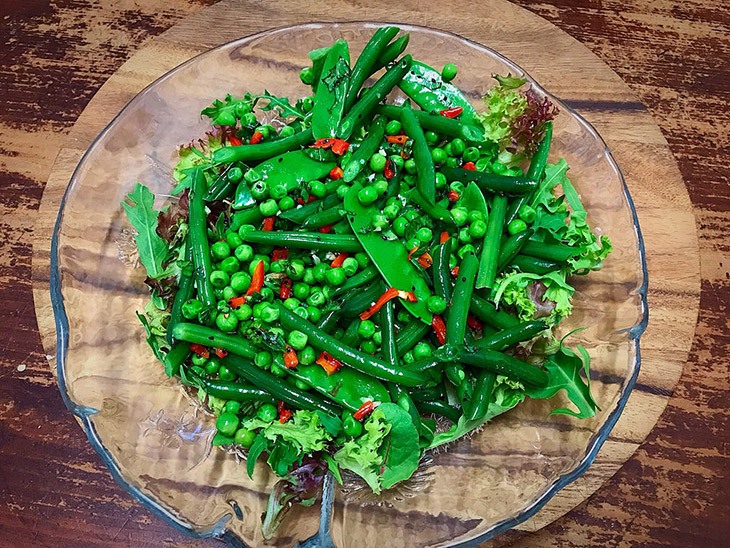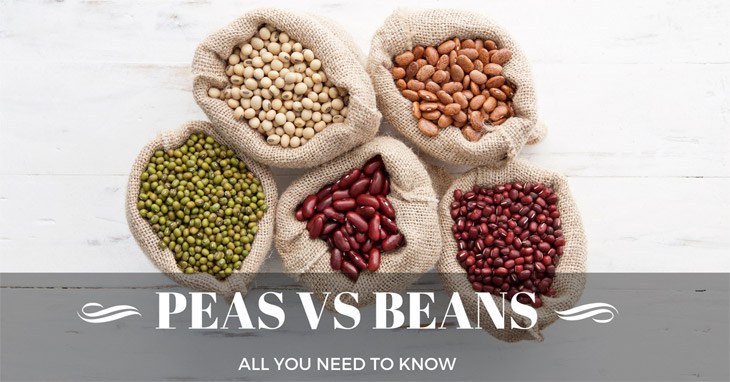Peas and beans are two of the most familiar food around the globe. However, most of us still have a hazy comprehension of these two seeds; many even mistakenly think they are the same.
This article will shed more light on the difference between peas and beans as well as other facts about them.
Continue Reading
Why are Peas and Beans Usually Misidentified?

Mix Peas Vs Beans
#1. Botanical Traits
Peas and beans as mentioned earlier, share the same origin and some outside features – both are legumes and seeds and have the same size – making many people erroneously regard them as one.
The fact that they both have many similar real-life applications also makes people become more easily confused.
#2. Linguistic Reason
The vernacular factor also plays an essential role in creating this peas-versus-beans confusion. In many regions of the world, peas and beans have the same name. For instance, in many countries, such as Vietnam, the two seeds are both called “đậu”.
While having some similarities, peas and beans still have distinctive characteristics. But before dissecting the difference between peas and beans, we need to understand some facts about each of those two seeds.
Beans

#1. Terminology
Botanically, beans are described as seeds or pods of large plants coming from the Fabaceae family (or Leguminosae).
Originally, beans were used to refer to fava bean (or broad bean). Subsequently, the term has been expanded to cover those of genus Phaseolus, such as runner bean, and genus Vigna.
In English, the term “bean” also alludes to other seeds or plants having resemblances with leguminous seeds. Many of them such as coffee, castor or cocoa are considered as bean for their bean-like shapes.
#2. Characteristics
- Appearance & Nutrition
Beans usually have oval or kidney-shape and are famous for being an extremely nourish source of food. They are rich in solvable fiber, a vital substance in human’s digest system and lowering blood cholesterol.
Additionally, products made from beans contain a high level of other macro- and micronutrients such as carbohydrates, folate, proteins and minerals.
- Cultivation
As annual crops, beans has a life cycle of one year. Yet, being summer plants, beans can only thrive in warm environments. Beans often develop in either vertical or horizontal direction. To acquire the vertical direction, beans need to have outside support to grow. The supporting structures are usually poles.
As the plants grow, the bean pods gradually become yellow and get dried, while the interior beans eventually turn from green to their mature color. This process normally takes 50 – 60 days to complete.
#3. Applications
- Food
In many parts of the world, especially developing nations, beans have been being the major component of daily meals, supplying human and animals a major amount of nutrients. Some of the most widely consumed beans may include dry bean, navy bean, common bean, etc.
- Other Usages
Beans are also used for many other agricultural and biotechnological purposes, including crop rotations, intercropping, producing green fertilizer and biofuels.
Peas

Green Peas - Via Harvesttotable.com
#1. Terminology
Peas are a branch of the beans group. The term “pea” refers to small-size globular seed or seed-pod of the fruit Pisum sativum. Botanists classify peapods as fruit;
However, they are considered as vegetables in cuisine. The name “pea” is also used to cover some other esculent Fabaceae such as cowpea or pigeon pea.
#2. Characteristics
- Appearance & Nutrition
Typical peas are small and round seeds, growing inside seed pods. Being a type of bean, peas certainly have the same nutritious values as their fellows. Peas often offer abundant of fiber, carbohydrate, proteins and minerals and, therefore, are highly recommended for usage.
- Cultivation
Peas, similar to beans, usually grow in two forms: pole and bush. The pole-shape peas also require a framework or vertical structure, such as a pole, to climb and develop. However, peas are winter plants and can only be grown during winter or late summer.
Peas are sown at 30 to 40 mm deep in the earth. Depending on planting conditions, vining peas can reach up to 1.5 meters.
#3. Applications
- Food
Peas are used on a daily-basis in many regions in the globe. In reality, products made from peas are mostly served in cans or frozen packages. Apart from being human food, peas, like beans, can be used to feed livestock.
- Other Uses
In the industry, peas have a broad range of applications such as crop rotations, green manure and biological fuels.
The Difference between Peas and Beans
As can be seen, peas and beans share many similarities, from coming from the same family to having many similar real-life applications. Nevertheless, each of them has distinct features that often are overlooked. Below are the contrasting characteristics between peas and beans.
Shape Of Seed
This is one of the most apparent differences between peas and beans. Beans are often oval or kidney-shaped. In contrast, peas have a spherical appearance.
Color
In terms of color, most beans are divided into red beans and white beans. Contrary to beans, peas cannot be categorized based on color.
Growing Patterns
Another distinct feature between the two is their climbing methods. Peas employ tendrils to increase the traction on the pole or framework, while beans can only twist around the vertical supporting structure, creating a spiral pattern.
Cultivation Timeline
While beans are summer crops and grow in warm regions, peas can only thrive in cold environment.
Physiological Structure
The internal part of peas and beans also disparate from each other. The stem of peas is usually empty, whereas beans possess a more solidified one.
Cotyledon Growth
Last but not least, beans and peas have different cotyledon development. The bean plants’ seed-leaves emerge from the earth, unlike those of peas. The below video will reveal more details about beans’ cotyledons.
Conclusion
Overall, the two seeds have many in common: having the same origin, containing similar nutrients as well as having many similar applications. However, all the identical characteristics cannot make them indistinguishable. If you take a closer attention, you can easily realize the difference between peas and beans.
I hope you have been more educated about these familiar seeds after reading this article. Please let me know your opinions in the comment section. Thank you very much for reading.

Leave a Reply